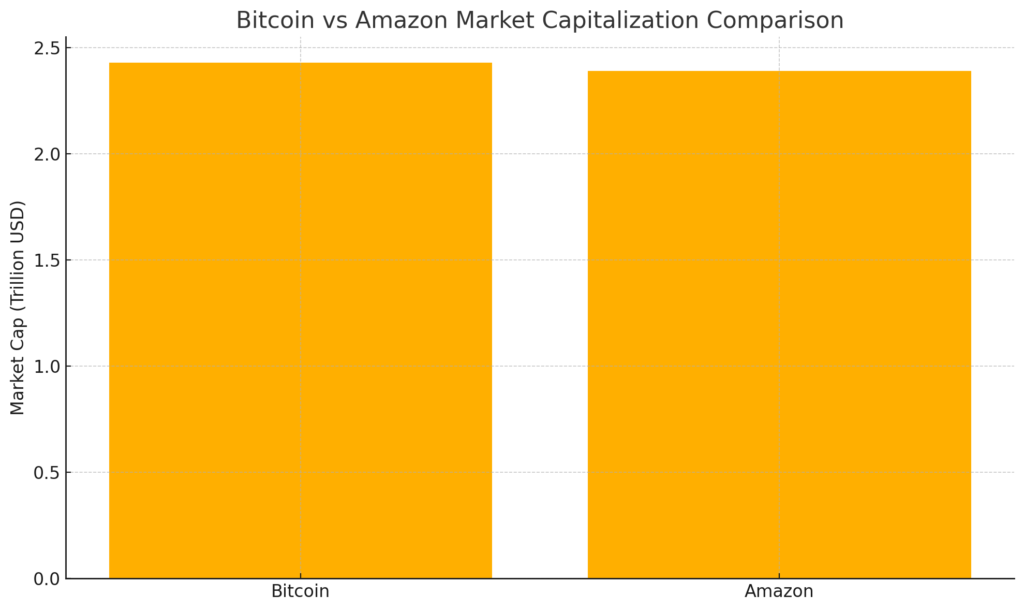
Main Points:
- Bitcoin briefly overtook Amazon to become the world’s fifth-largest asset by market capitalization.
- Experts recommend allocating 5% of portfolios to Bitcoin for diversification and growth potential.
- MicroStrategy expanded its holdings beyond 600,000 BTC, cementing corporate adoption trends.
- Regulatory and institutional catalysts—such as U.S. “Crypto Week” and surging ETF inflows—continue to drive Bitcoin’s ascent.
- Practical implications for investors: strategies, risk considerations, and emerging blockchain use cases.
1. Bitcoin’s Historic “Amazon Flip”: Ranking Fifth Globally
In mid‑July 2025, Bitcoin (BTC) made headlines by briefly surpassing Amazon’s market capitalization of $2.39 trillion to claim the fifth spot among global assets, reaching approximately $2.43 trillion at its peak. This milestone underscores Bitcoin’s transition from speculative novelty to a mainstream financial instrument.
This achievement occurred amid a week of intense regulatory focus in Washington—dubbed “Crypto Week”—where U.S. lawmakers advanced stablecoin regulations and debated broader market-structure reforms. Institutional investors, buoyed by spot Bitcoin ETFs that recorded a seven-day buying streak, poured over $1 billion in inflows just last Friday, highlighting a convergence of policy tailwinds and institutional demand.
Such a ranking shift signals that Bitcoin’s capped supply (21 million coins) and “digital gold” narrative have gained significant traction among both retail and professional investors. Market analysts now speculate Bitcoin could soon challenge the valuations of tech giants like Apple and Microsoft, with price targets of $142,000–$167,000 on the horizon.

Chart: Bitcoin vs. Amazon Market Capitalization
(See chart above for a visual comparison.)
2. “5% Bitcoin” Portfolio Strategy: Gold Investors Take Note
As Bitcoin cements its status among the top five assets globally, traditional safe‑haven investors—particularly gold allocators—are reexamining portfolio structures. A growing chorus of experts now advocate a 5% Bitcoin allocation to balance stability with asymmetric growth potential.
Comparative Advantages:
- Scarcity & Deflationary Supply: Like gold, Bitcoin has a finite supply, but with automated issuance halving events that further reinforce scarcity.
- Digital & Borderless: Bitcoin transfers require only internet access, eliminating physical storage costs and enabling near-instant cross-border settlement.
- Institutional Adoption: Over 265 public companies now hold Bitcoin on their balance sheets, up from 124 just six weeks ago. Such corporate conviction drives both price support and mainstream legitimacy.
By allocating 5% of a diversified portfolio to Bitcoin, investors aim to capture its high upside while capping downside exposure. This does not replace gold but rather complements it, blending gold’s historical stability with Bitcoin’s growth drivers—technological innovation, decentralized finance (DeFi) expansion, and a rising tide of regulatory clarity.
3. MicroStrategy’s “All‑In” Play: 600,000 BTC and Counting
MicroStrategy, the enterprise-software firm turned quasi–Bitcoin investment vehicle, made waves by crossing the 600,000 BTC mark in holdings, valued at over $73 billion at current prices. This bold “all‑in” strategy has reshaped corporate treasury management, prompting peers to reconsider digital assets as core balance‑sheet components.
Strategic Rationale:
- Inflation Hedge: Bitcoin offers a non‑correlated store of value against potential fiat depreciation.
- Shareholder Value: Early adopters of Bitcoin have outperformed traditional stock buybacks in terms of total shareholder returns over the past year.
- Market Signaling: Publicly disclosing large Bitcoin positions confers first‑mover advantage in the emerging digital‑asset economy.
MicroStrategy’s success has sparked a domino effect: companies in technology, retail, and even manufacturing are now exploring partial Bitcoin allocations. This trend dovetails with growing service offerings from custodians, OTC desks, and turnkey corporate solutions, simplifying enterprise adoption.
4. Regulatory & Institutional Catalysts: Sustaining the Rally
Bitcoin’s meteoric rise to the top five did not occur in isolation. Several concurrent developments have fueled this rally:
- U.S. “Crypto Week”: Legislative momentum in the U.S. House to formalize stablecoin frameworks and market‑structure reforms increased clarity for institutional investors.
- Spot ETF Inflows: Recent reports indicate weekly inflows exceeding $3.7 billion into Bitcoin ETFs, signaling robust demand from asset managers and retail investors alike.
- Global Political Backing: Key policymakers in Europe and Asia have echoed calls for balanced crypto oversight, reducing fragmentation and fostering cross-jurisdictional capital flows.
These catalysts not only support near‑term price momentum but also lay the groundwork for broader blockchain applications—ranging from tokenized securities to decentralized identity systems—setting the stage for the next wave of crypto innovation.
5. Practical Takeaways for Investors and Blockchain Practitioners
For those scouting new digital assets or blockchain implementations, the following considerations are pivotal:
- Risk Management: Cap Bitcoin exposure at 5–10%, complement with stablecoins, high‑quality altcoins (e.g., Ether, Solana), and traditional assets.
- Custody Solutions: Leverage institutional-grade custodians or multi-sig wallets to mitigate counterparty risk.
- Regulatory Compliance: Track regional licensing requirements (e.g., VASP registration in the Philippines, FATF travel‑rule adherence).
- DeFi Integration: Explore yield‑generating opportunities (staking, lending) while accounting for smart‑contract vulnerabilities.
- Real‑World Use Cases: Pilot blockchain for supply‑chain provenance, cross‑border micropayments, or digital identity frameworks.
By adopting a structured, research‑driven approach, investors can align with emerging trends without succumbing to hype cycles.
Conclusion
Bitcoin’s dramatic ascent past Amazon to become the world’s fifth‑largest asset marks a watershed moment in financial history. Fueled by institutional demand, regulatory progress, and visionary corporate strategies, the cryptocurrency has transcended its speculative roots to assume a central role in diversified portfolios. For gold investors, a 5% allocation to Bitcoin offers a compelling hedge; for enterprises, onboarding digital assets can unlock new value streams; and for blockchain practitioners, the rally underscores the urgency of building robust, compliant infrastructures. As the digital‑asset ecosystem matures, the principles of scarcity, decentralization, and programmability will drive the next generation of investment strategies—ushering in a truly global, blockchain‑enabled financial order.

